Is your Audi Q7 not performing as expected? Show Boost Q7 Vcds logging helps diagnose and optimize your vehicle’s performance. CAR-CODING.EDU.VN offers expert remote support to guide you through the process, ensuring accurate data collection and interpretation. With our assistance, you can unlock hidden features, troubleshoot issues, and maximize your Q7’s potential. Our services include ECU flashing, variant coding, and comprehensive technical support.
Contents
- 1. What is VCDS and Why Use it to Show Boost on Your Q7?
- 2. Who Needs VCDS Boost Logging and What are the Benefits?
- 3. What Equipment is Needed to Show Boost on a Q7 with VCDS?
- 4. How to Connect VCDS to Your Audi Q7 for Boost Monitoring?
- 5. Step-by-Step Guide: How to Show Boost Q7 VCDS Logging
- 6. Understanding VCDS Logging Parameters for Audi Q7 Boost
- 7. Interpreting Your Audi Q7 VCDS Boost Logs: A Comprehensive Guide
- 8. Troubleshooting Common Issues During Q7 VCDS Boost Logging
- 9. Advanced VCDS Coding Options for Audi Q7 Performance Enhancement
- 10. Why Choose CAR-CODING.EDU.VN for Remote VCDS Support?
- 11. Frequently Asked Questions (FAQ) About VCDS Boost Logging
Table of Contents:
- What is VCDS and Why Use it to Show Boost on Your Q7?
- Who Needs VCDS Boost Logging and What are the Benefits?
- What Equipment is Needed to Show Boost on a Q7 with VCDS?
- How to Connect VCDS to Your Audi Q7 for Boost Monitoring?
- Step-by-Step Guide: How to Show Boost Q7 VCDS Logging
- Understanding VCDS Logging Parameters for Audi Q7 Boost
- Interpreting Your Audi Q7 VCDS Boost Logs: A Comprehensive Guide
- Troubleshooting Common Issues During Q7 VCDS Boost Logging
- Advanced VCDS Coding Options for Audi Q7 Performance Enhancement
- Why Choose CAR-CODING.EDU.VN for Remote VCDS Support?
- Frequently Asked Questions (FAQ) About VCDS Boost Logging
1. What is VCDS and Why Use it to Show Boost on Your Q7?
VCDS, or Vag-Com Diagnostic System, is a software and hardware package developed by Ross-Tech used for diagnosing and coding Volkswagen Audi Group (VAG) vehicles, including the Audi Q7. It provides access to a wealth of diagnostic information, allowing users to monitor various parameters, including boost pressure. Displaying boost on your Q7 VCDS helps ensure your engine operates within safe and optimal performance ranges.
- Comprehensive Diagnostics: VCDS offers in-depth diagnostic capabilities, far beyond generic OBDII scanners.
- Real-Time Data: Monitor live data, including boost pressure, to assess engine performance under various conditions.
- Coding and Adaptation: Perform coding and adaptation to customize vehicle settings and enable hidden features.
- Fault Code Reading and Clearing: Identify and clear fault codes to resolve issues and maintain vehicle health.
- User-Friendly Interface: Despite its advanced capabilities, VCDS offers a user-friendly interface suitable for both enthusiasts and professionals.
2. Who Needs VCDS Boost Logging and What are the Benefits?
VCDS boost logging is essential for Audi Q7 owners and technicians who want to monitor and optimize engine performance. Whether you’re diagnosing a performance issue or fine-tuning a modified engine, VCDS logging provides valuable insights.
- Tuned Vehicles: If you’ve modified your Q7’s engine with aftermarket tuning, VCDS logging is crucial to ensure the tune is performing as expected and to identify potential issues.
- Performance Monitoring: Track boost levels to ensure your engine is delivering optimal power and efficiency.
- Troubleshooting: Diagnose boost-related issues such as leaks, faulty sensors, or malfunctioning components.
- Maintenance: Monitor boost levels over time to identify potential problems before they lead to significant repairs.
- Customization: Unlock hidden features and customize vehicle settings through VCDS coding.
3. What Equipment is Needed to Show Boost on a Q7 with VCDS?
To show boost on your Audi Q7 using VCDS, you’ll need specific hardware and software. Here’s a breakdown of the necessary equipment:
- VCDS Interface Cable: This cable connects your laptop to the Q7’s OBDII port. Ensure it’s a genuine Ross-Tech cable for full functionality and reliability.
- Laptop with Windows: VCDS software is compatible with Windows operating systems (XP, Vista, 7, 8, 10).
- VCDS Software: Download and install the latest version of VCDS software from the Ross-Tech website.
- Audi Q7 Vehicle: Your Audi Q7, model years 2007-2015.
4. How to Connect VCDS to Your Audi Q7 for Boost Monitoring?
Connecting VCDS to your Audi Q7 is a straightforward process. Follow these steps to establish a connection for boost monitoring:
- Locate the OBDII Port: Find the OBDII port under the dashboard on the driver’s side of your Audi Q7.
- Connect the VCDS Cable: Plug the VCDS interface cable into the OBDII port.
- Connect to Laptop: Connect the other end of the cable to your laptop’s USB port.
- Turn on Ignition: Turn the ignition to the “ON” position without starting the engine.
- Launch VCDS Software: Open the VCDS software on your laptop.
- Test Connection: Click the “Options” button in VCDS and then click “Test” to verify the connection. A successful test indicates that VCDS is communicating with your Q7.
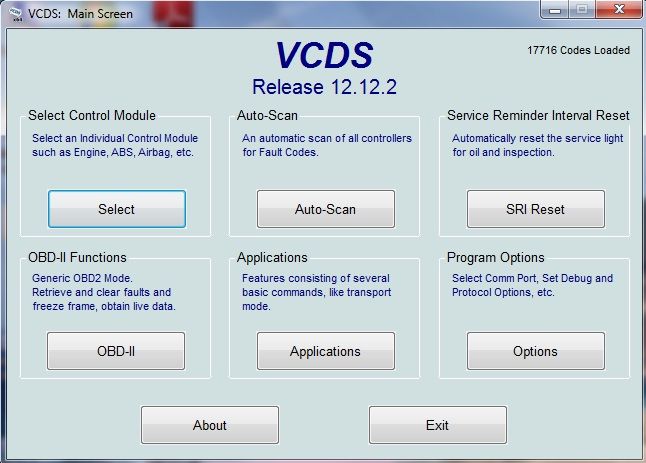 VCDS Main Menu
VCDS Main Menu
5. Step-by-Step Guide: How to Show Boost Q7 VCDS Logging
Once you’re connected, follow these steps to initiate boost logging on your Audi Q7:
- Select Control Module: From the VCDS main menu, click “Select Control Module.”
- Choose Engine Module: Under the “Common” tab, click “01-Engine.”
- Access Advanced Measuring Values: In the Engine Controller module, click “Adv. Meas. Values” to access the logging section.
- Select Ambient Air Pressure: Choose “Ambient Air Pressure” from the parameter list, note the value, and uncheck the box. This value will be used later to calculate boost.
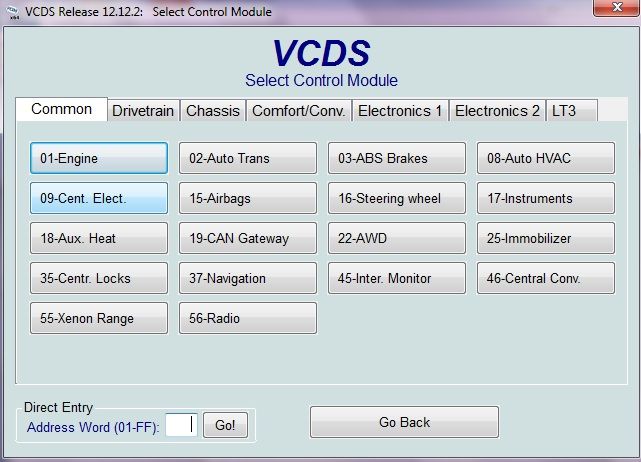 VCDS Engine Module
VCDS Engine Module
-
Select Boost Parameters: Choose the boost-related parameters you want to log. Recommended parameters include:
- Charge air pressure specified value
- Intake manifold pressure; absolute
- Engine speed
- Accelerator position
-
Save Parameter List: Save your parameter list for future use by clicking the “VCDS” icon and naming the file appropriately.
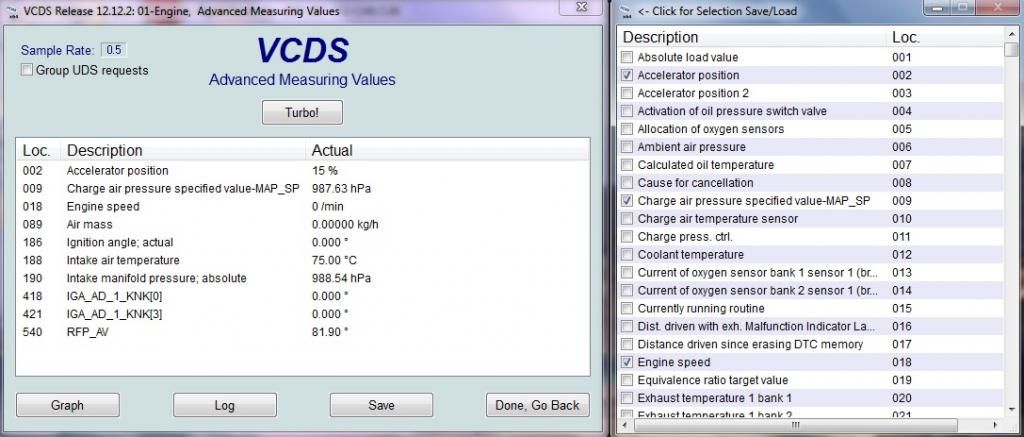 VCDS Logging Fields
VCDS Logging Fields
- Enable Turbo Mode and Group UDS Requests: Click the “Turbo” button and check the “Group UDS requests” box. This optimizes logging speed and synchronizes timestamps for accurate data.
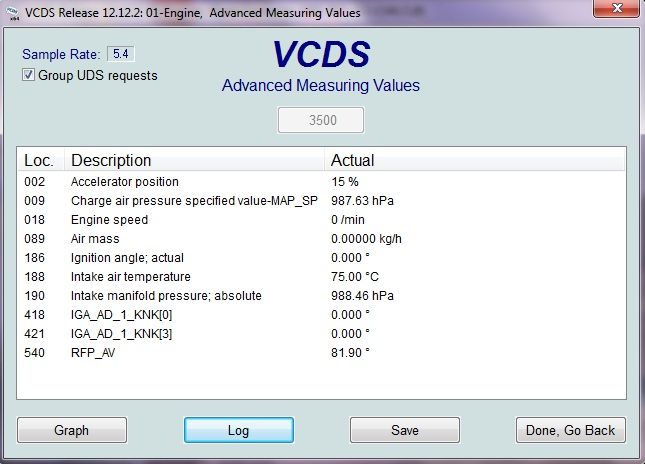 VCDS Log Screen
VCDS Log Screen
-
Start Logging: Click the “Log” button, then click “Start” to begin logging.
-
Perform Logging Run: Drive your Q7 under the conditions you want to log, such as a full throttle pull in 3rd gear.
-
Stop Logging: Once you’ve captured the necessary data, click “Stop” and then “Done, close.” The log file will be saved in the VCDS/Logs folder as a .CSV file.
6. Understanding VCDS Logging Parameters for Audi Q7 Boost
Selecting the right parameters is crucial for accurate boost analysis. Here are some essential parameters for logging boost on your Audi Q7:
| Parameter | Description | Units | Importance |
|---|---|---|---|
| Charge Air Pressure Specified Value | Target boost pressure set by the ECU | hPa | Essential for comparing actual vs. target boost |
| Intake Manifold Pressure; Absolute | Actual pressure in the intake manifold, including ambient air pressure | hPa | Measures the real-time boost level |
| Engine Speed | Engine RPM | RPM | Provides context for boost levels (e.g., boost at different RPMs) |
| Accelerator Position | Percentage of throttle being applied | % | Indicates driver demand and load on the engine |
| Ambient Air Pressure | The atmospheric pressure | hPa | To calculate actual boost (Intake Manifold Pressure – Ambient Air Pressure) |
| Intake Air Temperature | Temperature of the air entering the intake manifold | °C | Affects air density and engine performance |
| Mass Air Flow (MAF) | Measures the amount of air entering the engine | g/s | Helps assess engine efficiency and identify potential air leaks |
| Knock Retardation (Individual Cylinders) | Amount of timing being pulled by the ECU due to detected engine knock | Degrees | Indicates potential issues with fuel quality, tuning, or engine health |
| Lambda/Air-Fuel Ratio | The ratio of air to fuel entering the engine | Important for assessing engine health and tuning optimization | |
| Ignition Angle Actual | The actual ignition timing | Degrees | Helps diagnose issues with ignition timing and engine performance |
7. Interpreting Your Audi Q7 VCDS Boost Logs: A Comprehensive Guide
Interpreting VCDS boost logs requires understanding how various parameters interact. Here’s a guide to help you analyze your Q7’s boost performance:
- Compare Specified vs. Actual Boost: The most critical aspect is comparing the “Charge Air Pressure Specified Value” to the “Intake Manifold Pressure; Absolute” (subtracting the ambient air pressure). Significant deviations can indicate issues such as boost leaks, a faulty diverter valve, or a malfunctioning turbocharger.
- Analyze Boost Curve: Plotting boost pressure against engine RPM reveals the boost curve. A healthy engine should exhibit a smooth and consistent boost curve without spikes or dips.
- Check for Boost Leaks: A common issue is boost leaks, which can occur in hoses, intercoolers, or connections. These leaks cause a loss of boost pressure, leading to reduced performance. Look for lower-than-expected boost levels, especially at higher RPMs.
- Diverter Valve Function: The diverter valve (also known as a bypass valve) regulates boost pressure by venting excess pressure when the throttle closes. A faulty diverter valve can cause boost oscillations or a complete loss of boost.
- Turbocharger Performance: If boost levels are consistently low, the turbocharger itself may be failing. Check for unusual noises or physical damage to the turbocharger.
- Knock Retardation: High levels of knock retardation indicate that the engine is experiencing knock, which can damage the engine. Investigate the cause of the knock, such as poor fuel quality, excessive heat, or incorrect timing.
- Air-Fuel Ratio (AFR): Proper AFR is critical for engine health and performance. The logs should show if the engine is running too rich (too much fuel) or too lean (not enough fuel).
8. Troubleshooting Common Issues During Q7 VCDS Boost Logging
During VCDS boost logging, you might encounter several issues. Here’s how to troubleshoot some common problems:
- Connection Problems: If VCDS cannot connect to your Q7, ensure the cable is properly connected, the ignition is on, and the correct COM port is selected in VCDS settings.
- Slow Logging Speed: Slow logging speeds can result in inaccurate data. Enable “Turbo” mode and “Group UDS requests” to improve logging performance.
- Missing Parameters: If a parameter is missing from the list, ensure you’re using the correct control module (01-Engine) and that the parameter is supported by your Q7’s ECU.
- Incorrect Data: If the data seems incorrect, verify that you’ve selected the correct parameters and that your VCDS software is up to date.
- Communication Errors: Communication errors can occur due to faulty cables or incompatible software versions. Try using a different cable or updating your VCDS software.
9. Advanced VCDS Coding Options for Audi Q7 Performance Enhancement
Beyond basic boost logging, VCDS offers advanced coding options to enhance your Audi Q7’s performance and customize its features:
- Throttle Response: Adjust throttle response settings for improved acceleration.
- Launch Control: Enable launch control for optimized starts.
- Exhaust Sound: Modify exhaust sound settings for a sportier tone.
- Gauge Staging: Activate gauge staging (needle sweep) at startup.
- Hidden Menu: Enable hidden menu options for advanced control.
Warning: Incorrect coding can cause malfunctions or damage to your vehicle. It’s crucial to have a thorough understanding of the coding process and to back up your original settings before making any changes. If you’re unsure, consult with a qualified technician or use a reliable coding service like CAR-CODING.EDU.VN.
10. Why Choose CAR-CODING.EDU.VN for Remote VCDS Support?
CAR-CODING.EDU.VN provides expert remote VCDS support to help you get the most out of your Audi Q7. Here’s why you should choose us:
- Expert Technicians: Our team of experienced technicians specializes in VAG vehicles and VCDS coding.
- Remote Assistance: We offer remote support, allowing us to assist you from anywhere with an internet connection.
- Safe and Reliable: We prioritize the safety of your vehicle and use proven coding techniques to minimize risks.
- Custom Solutions: We provide tailored solutions to meet your specific needs and preferences.
- Affordable Pricing: Our services are competitively priced, offering excellent value for the expertise and support you receive.
- Real-Time Support: We offer support for resolving complex coding issues.
- Error and Warnings: We can turn off unneeded warnings.
- Feature Activation: Our team can activate desired hidden features on your car.
- Time and Cost Effective: Our service is designed to save you time and money.
Contact CAR-CODING.EDU.VN today at +1 (641) 206-8880 or visit our website at CAR-CODING.EDU.VN to learn more about our remote VCDS support services. Our office is located at 100 Tech Innovation Dr, Suite 500, San Jose, CA 95110, United States.
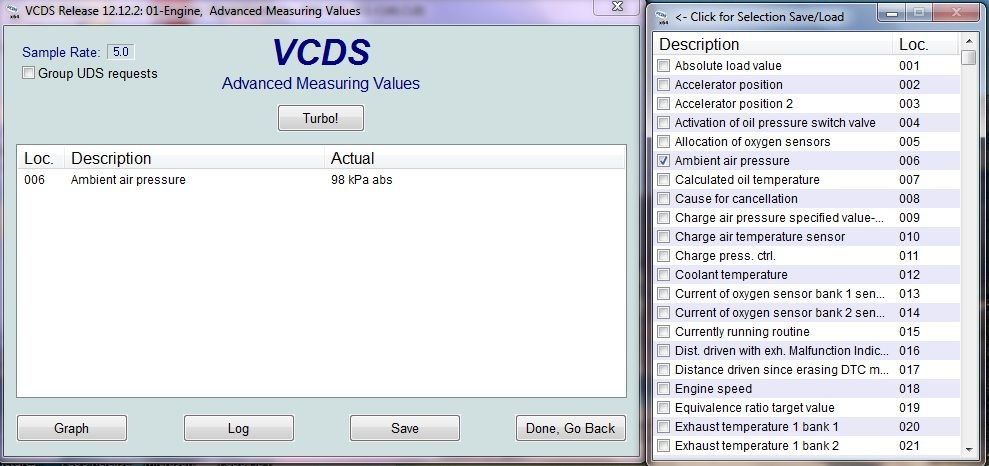 VCDS Ambient Air Pressure
VCDS Ambient Air Pressure
11. Frequently Asked Questions (FAQ) About VCDS Boost Logging
Q: Is VCDS boost logging safe for my Audi Q7?
A: Yes, when performed correctly. Always use a genuine Ross-Tech cable and follow the proper procedures. Back up your original settings before making any changes and consult with experts like CAR-CODING.EDU.VN for guidance.
Q: Can I use a generic OBDII scanner for boost logging?
A: While generic OBDII scanners can read basic parameters, they lack the advanced capabilities of VCDS for accurate and detailed boost logging.
Q: How much does remote VCDS support from CAR-CODING.EDU.VN cost?
A: The cost of our remote VCDS support varies depending on the complexity of the task. Contact us for a personalized quote.
Q: What types of Audi Q7 models do you support?
A: We support most Audi Q7 models from 2007-2015 with 3.0 TFSI engines. Contact us to confirm compatibility with your specific model.
Q: What if I encounter errors during the coding process?
A: Contact CAR-CODING.EDU.VN immediately for remote assistance. Our technicians can diagnose and resolve coding errors to prevent damage to your vehicle.
Q: What parameters should I log to diagnose a boost leak?
A: Log “Charge Air Pressure Specified Value,” “Intake Manifold Pressure; Absolute,” “Engine Speed,” and “Accelerator Position” to identify boost discrepancies and potential leaks.
Q: Can VCDS boost logging help me improve my Q7’s fuel efficiency?
A: Yes, by monitoring parameters like AFR and identifying issues such as boost leaks or faulty sensors, you can optimize engine performance and improve fuel efficiency.
Q: Do I need any special tools besides the VCDS cable and software?
A: No, the VCDS cable and software are the primary tools needed for boost logging. A laptop with Windows is also required.
Q: How often should I perform VCDS boost logging on my Q7?
A: Perform boost logging whenever you suspect a performance issue or after making modifications to your engine. Regular logging can help you identify potential problems early.
Q: Where can I find the VCDS log files on my computer?
A: The log files are typically saved in the Ross-Tech/VCDS/Logs folder on your C:/ drive or wherever the Ross-Tech software is installed.
Are you ready to unlock the full potential of your Audi Q7? Contact CAR-CODING.EDU.VN now for expert remote VCDS support and experience the difference! Call us at +1 (641) 206-8880 or visit CAR-CODING.EDU.VN to get started. Don’t let coding complexities hold you back – let our experts guide you to success!